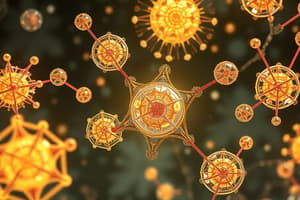Podcast
Questions and Answers
What is the correct formula for Magnesium oxide?
What is the correct formula for Magnesium oxide?
- MgO (correct)
- MgO2
- Mg2O
- MgO3
Which compound has the formula H2O?
Which compound has the formula H2O?
- Hydrogen chloride
- Hydrogen gas
- Oxygen gas
- Water (correct)
What happens to the valency when writing the formula for a compound?
What happens to the valency when writing the formula for a compound?
- Valencies are multiplied.
- Valencies are interchanged. (correct)
- Valencies are added together.
- Valencies are ignored.
Which of the following is the correct formula for Carbon dioxide?
Which of the following is the correct formula for Carbon dioxide?
In which formula are the subscripts not written?
In which formula are the subscripts not written?
What is the valency of Hydrogen when writing chemical formulae?
What is the valency of Hydrogen when writing chemical formulae?
What is the formula for Ammonia?
What is the formula for Ammonia?
Which combination represents the constituents of Common salt?
Which combination represents the constituents of Common salt?
What does the subscript in a molecular formula indicate?
What does the subscript in a molecular formula indicate?
Which of the following elements has a valency of 2?
Which of the following elements has a valency of 2?
What is the molecular formula for a water molecule?
What is the molecular formula for a water molecule?
Which element has the molecular formula S8?
Which element has the molecular formula S8?
How many atoms of nitrogen are in one molecule of nitrogen gas N2
How many atoms of nitrogen are in one molecule of nitrogen gas N2
What is needed to write a molecular formula?
What is needed to write a molecular formula?
What characterizes a molecule compared to an atom?
What characterizes a molecule compared to an atom?
Which of the following best defines atomicity?
Which of the following best defines atomicity?
Which of the following pairs of elements are both diatomic?
Which of the following pairs of elements are both diatomic?
What type of molecular structure do noble gases have?
What type of molecular structure do noble gases have?
Which statement about atoms is correct?
Which statement about atoms is correct?
What distinguishes polyatomic molecules from diatomic molecules?
What distinguishes polyatomic molecules from diatomic molecules?
Which molecule is classified as triatomic?
Which molecule is classified as triatomic?
How is a water molecule composed?
How is a water molecule composed?
What does a molecular formula indicate?
What does a molecular formula indicate?
Which of the following compounds is polyatomic?
Which of the following compounds is polyatomic?
What is the molecular formula representation for hydrogen chloride?
What is the molecular formula representation for hydrogen chloride?
Which statement about diatomic molecules is correct?
Which statement about diatomic molecules is correct?
How many atoms are in a molecule of carbon dioxide?
How many atoms are in a molecule of carbon dioxide?
What distinguishes molecules of an element from compounds?
What distinguishes molecules of an element from compounds?
Which statement accurately defines a compound?
Which statement accurately defines a compound?
What is the correct description of an atom?
What is the correct description of an atom?
What represents the composition of a molecule?
What represents the composition of a molecule?
Which of the following is NOT a classification of elements?
Which of the following is NOT a classification of elements?
What distinguishes an element from a compound?
What distinguishes an element from a compound?
Which statement best describes an atom?
Which statement best describes an atom?
What distinguishes molecules from atoms?
What distinguishes molecules from atoms?
What is true about the atoms of different elements?
What is true about the atoms of different elements?
Which of the following best describes noble gases?
Which of the following best describes noble gases?
How are molecules formed?
How are molecules formed?
Which property is maintained by an atom during physical and chemical changes?
Which property is maintained by an atom during physical and chemical changes?
What is a characteristic feature of a compound's molecule?
What is a characteristic feature of a compound's molecule?
The term 'atom' derives from which Greek word, and what does it imply?
The term 'atom' derives from which Greek word, and what does it imply?
Flashcards are hidden until you start studying
Study Notes
Atoms and Molecules
- An atom is the smallest particle of an element that possesses all the properties of that element and may or may not have independent existence.
- Atoms of most elements are very reactive and do not exist as free atoms; they exist in combination with the atoms of the same element or other elements.
- All atoms of an element are similar or identical and exhibit the same properties.
- The atoms of one element are different from those of other elements and have different properties.
- An atom maintains its properties through all physical and chemical changes.
Molecules
- A molecule is the smallest particle of an element or a compound that has independent existence and shows all the properties of that substance.
- Molecules are formed by the combination of the atoms of the same element or of different elements.
- A molecule of a compound has atoms of different elements combined in a fixed whole-number ratio.
- The atoms in a molecule are held together by attractive forces called chemical bonds.
Elements
- An element is a pure substance that cannot be broken down into simpler substances by any physical or ordinary chemical means.
- Elements can be classified into metals, non-metals, metalloids, and noble or inert gases based on their properties.
- The symbol of an element is a single-letter or two-letter abbreviation (short name) of its full name.
Compounds
- A compound is a substance made up of two or more elements chemically combined together in a fixed ratio.
- The formula of a compound shows the number of atoms of different elements present in one molecule of that compound.
- The combining capacity of an element is known as its valency, which is used to find out how the atoms of an element will combine with the atoms of another element to form a compound.
Molecular Formula
- The molecular formula represents the composition of a molecule of an element or a compound.
- The molecular formula of an element shows the number of atoms present in one molecule of that element.
- The molecular formula of a compound shows the number of atoms of different elements present in one molecule of that compound.
Subscript
- The subscript in a molecular formula tells us how many atoms are present in one molecule of that element.
- The subscript is a small number written below and to the right of the symbol of the element.
Atomicity
- The number of atoms present in a molecule of an element is called its atomicity.
- Elements such as helium, neon, and argon exist as single atoms and are called monoatomic molecules.
- Elements such as oxygen, hydrogen, and nitrogen exist as diatomic molecules, meaning their molecules are composed of two atoms.
- Molecules containing more than two atoms are polyatomic.
Studying That Suits You
Use AI to generate personalized quizzes and flashcards to suit your learning preferences.




